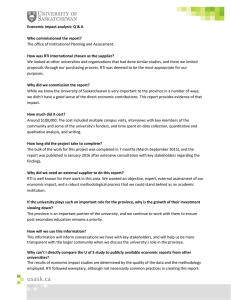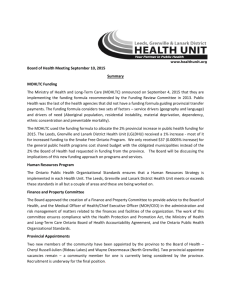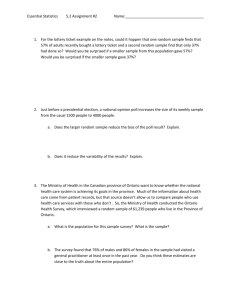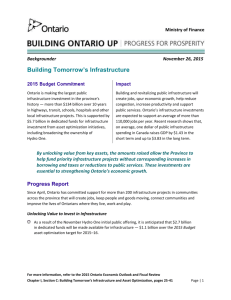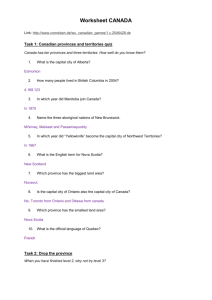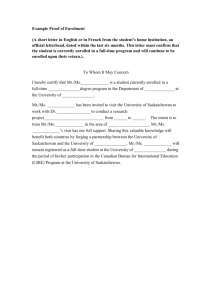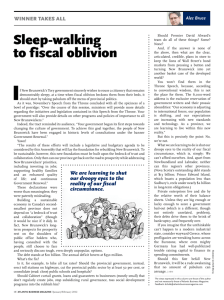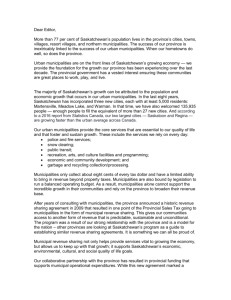Corporate Income Tax Rates by Province — 2015
advertisement
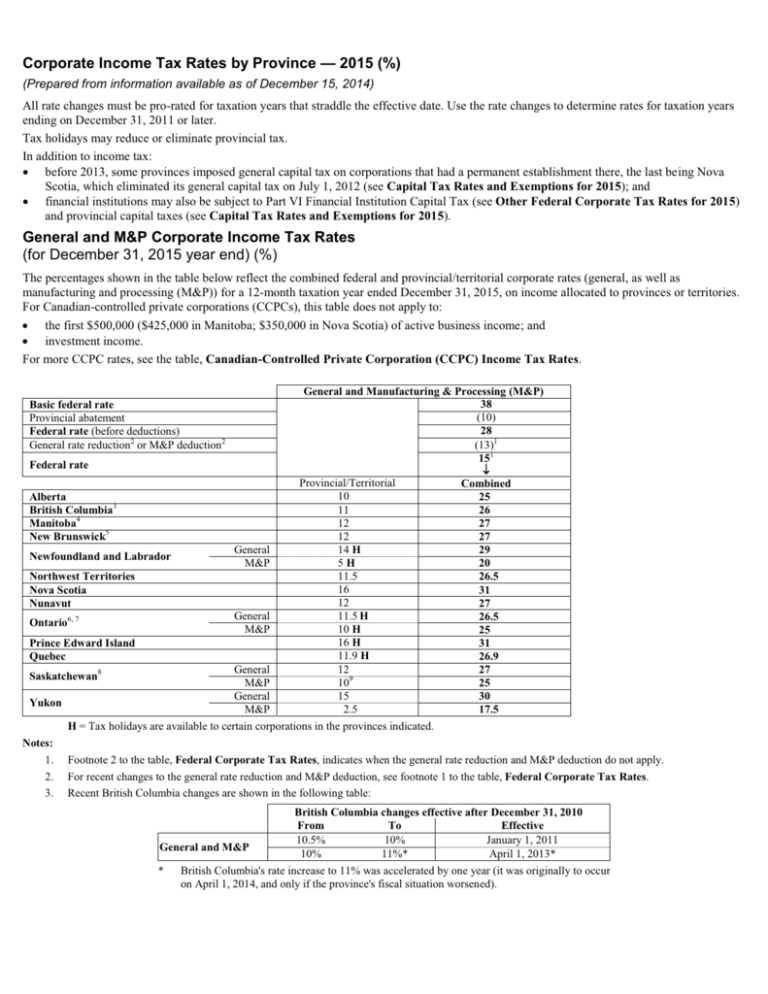
Corporate Income Tax Rates by Province — 2015 (%) (Prepared from information available as of December 15, 2014) All rate changes must be pro-rated for taxation years that straddle the effective date. Use the rate changes to determine rates for taxation years ending on December 31, 2011 or later. Tax holidays may reduce or eliminate provincial tax. In addition to income tax: x before 2013, some provinces imposed general capital tax on corporations that had a permanent establishment there, the last being Nova Scotia, which eliminated its general capital tax on July 1, 2012 (see Capital Tax Rates and Exemptions for 2015); and x financial institutions may also be subject to Part VI Financial Institution Capital Tax (see Other Federal Corporate Tax Rates for 2015) and provincial capital taxes (see Capital Tax Rates and Exemptions for 2015). General and M&P Corporate Income Tax Rates (for December 31, 2015 year end) (%) The percentages shown in the table below reflect the combined federal and provincial/territorial corporate rates (general, as well as manufacturing and processing (M&P)) for a 12-month taxation year ended December 31, 2015, on income allocated to provinces or territories. For Canadian-controlled private corporations (CCPCs), this table does not apply to: x the first $500,000 ($425,000 in Manitoba; $350,000 in Nova Scotia) of active business income; and x investment income. For more CCPC rates, see the table, Canadian-Controlled Private Corporation (CCPC) Income Tax Rates. General and Manufacturing & Processing (M&P) 38 (10) 28 (13)1 151 Federal rate p Provincial/Territorial Combined 10 Alberta 25 British Columbia3 11 26 Manitoba4 12 27 New Brunswick5 12 27 General 14 H 29 Newfoundland and Labrador M&P 5H 20 11.5 Northwest Territories 26.5 16 Nova Scotia 31 12 Nunavut 27 General 11.5 H 26.5 6, 7 Ontario M&P 10 H 25 16 H Prince Edward Island 31 11.9 H Quebec 26.9 General 12 27 8 Saskatchewan M&P 109 25 General 15 30 Yukon M&P 2.5 17.5 H = Tax holidays are available to certain corporations in the provinces indicated. Basic federal rate Provincial abatement Federal rate (before deductions) General rate reduction2 or M&P deduction2 Notes: 1. 2. 3. Footnote 2 to the table, Federal Corporate Tax Rates, indicates when the general rate reduction and M&P deduction do not apply. For recent changes to the general rate reduction and M&P deduction, see footnote 1 to the table, Federal Corporate Tax Rates. Recent British Columbia changes are shown in the following table: General and M&P * British Columbia changes effective after December 31, 2010 From To Effective 10.5% 10% January 1, 2011 10% 11%* April 1, 2013* British Columbia's rate increase to 11% was accelerated by one year (it was originally to occur on April 1, 2014, and only if the province's fiscal situation worsened). 4. 5. Manitoba's general and M&P rate was scheduled to drop from 12% to 11% at a date to be determined, subject to balanced budget requirements; however, this is no longer being considered by the province. Recent New Brunswick changes are shown in the following table: General and M&P New Brunswick changes effective after December 31, 2010 From To Effective 11% 10%* July 1, 2011 10% 12% July 1, 2013 * 6. New Brunswick repealed the legislated corporate income tax rate of 8% that was to apply on July 1, 2012. Recent Ontario changes are shown in the following table: General Ontario changes effective after December 31, 2010 From To Effective 12% 11.5%* July 1, 2011 * 7. 8. Ontario’s general income tax rate is frozen at 11.5%, until the province returns to a balanced budget (scheduled for 2017-18). The rate was to drop to 11% on July 1, 2012, and to 10% on July 1, 2013. Corporations subject to Ontario income tax that, on an associated basis, have annual gross revenues of $100 million or more and total assets of $50 million or more may also be liable for a 2.7% corporate minimum tax (CMT) based on adjusted book income. The minimum tax is payable only to the extent that it exceeds the regular Ontario income tax liability. Planned Saskatchewan changes are shown in the following table: General * 9. Saskatchewan changes effective after December 31, 2010 From To Effective 12% 10%* To be determined* Saskatchewan's 2013 budget deferred the province's general corporate income tax rate decrease to 10% (from 12%) until it is "affordable and sustainable, within a balanced budget." The province is no longer committed to reducing the rate by 2015, as had been announced in its 2012 throne speech. The general rate (12% in 2015) is the maximum Saskatchewan rate. A rebate of up to the difference between the general rate and 10% (2% in 2015) of manufacturing profits allocated to Saskatchewan is available.
